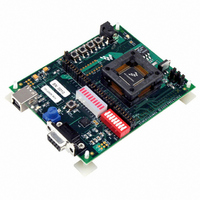DEMO9S08AW60E Freescale Semiconductor, DEMO9S08AW60E Datasheet

DEMO9S08AW60E
Specifications of DEMO9S08AW60E
Related parts for DEMO9S08AW60E
DEMO9S08AW60E Summary of contents
Page 1
... DEMO9S08AW60E Quick Start Guide Introduction and Default Settings This guide will walk you through how to connect the DEMO9S08AW60E board to your PC, install the correct version of CodeWarrior Development Studio, run the DEMO9S08AW60_TEST program, and how to program the board with the DEMO9S08AW60_APP source code. The source code for DEMO9S08AW60_TEST is provided on the included documentation CD in the " ...
Page 2
... Quick Start Guide. You must have administrator privileges to install CodeWarrior. Run the DEMO9S08AW60_TEST Program The DEMO9S08AW60E is shipped with the AW60_TEST program stored in on-chip FLASH memory. You may view the source code for this program by accessing the "AW60_TEST.zip" file on the included documentation CD (located in the "Examples" folder). ...
Page 3
... Values will be displayed in the terminal window based on the amount of light sensed by the photocell IC (U4). Vary the amount of light available to the photocell and watch the values change. Press SW4 when you are ready to move on to the accelerometer demo. Freescale Semiconductor DEMO9S08AW60E Quick Start Guide, Rev. 0.4 3 ...
Page 4
... Two columns of values will be displayed in the terminal window. The first is the X output of the accelerometer (U5) the second is the Y output. Move the DEMO9S08AW60E in the X and Y directions to see the values change. Press SW1 to complete the demo. Troubleshooting VDD LED does not turn on - Make sure jumper W2 is set to the USB (2-3) position - Make sure the USB drivers (located on the CodeWarrior 5 ...



